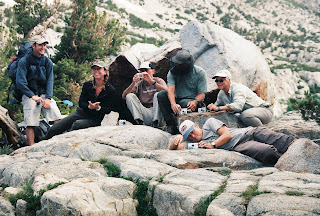Fresh on the heels of the 2010 WV Photo Contest seems as good a time as any to talk photography – especially as the 2010 trip season kicks into high gear.
As we get closer and closer to the trailhead and run down our packing list, gather up the “ten essentials” and sort out what to take and what to jettison, we each invariably head into the backcountry with that “other essential”: a camera. You won’t find it listed in any survival handbooks, but few of us – including myself – will leave home without it.
With that in mind, and as I myself prepare to head to Idaho’s Selway Bitterroot Wilderness next month, here are a few tips to set up your digital camera for optimal field use and maximum battery life – an ever-so precious resource when you’re miles from the nearest electrical outlet.
1) Turn Off Auto ISO – ISO 1600 on a sunny day? Not a chance, but it can happen – a camera’s metering system is no substitute for the human eye. To maximize image quality, give yourself control over the ISO. While many cameras do a good job across a range of ISO settings, the camera’s metering system isn’t foolproof and may choose a higher ISO setting when a lower ISO would suffice, sacrificing image quality in the process.
2) Turn Off Auto Rotate – Always looking at your LCD to review your last picture? Good – now get your money’s worth. When your camera is set to auto rotate, every vertical photograph is displayed in the camera’s horizontal LCD as a vertical image. What many of us fail to realize is that this forces the taller vertical image to fit in the shorter horizontal LCD. Bottom line: in an age of bigger and better LCDs, your vertical image is compressed and over half of your LCD screen is empty! Turn off auto rotate and you’ll see more – and take better pictures.
3) Skip Deletions – Tempting as it may be to clean up your photographs as you take them, doing so consumes precious battery life. Fight the urge. Unless, that is, you don’t mind hiking through scenic meadows, mountain vistas, and pristine wilderness with a dead camera. No doubt nothing beats the real thing, but it’s always nice to have a little bit of juice left should that “once-in-a-lifetime” opportunity arise. Your friends and family will appreciate it.
4) Dim the LCD Screen and Let it Sleep – Simple. The brighter it is and longer it’s on, the greater the drain on the battery.
5) Conserve Your Shots – Surely one of the greatest attractions of digital photography is the ability to take countless shots without sacrificing pack weight and space. Gone are the days (at least for those of us who have made the leap from film) of carrying a dozen rolls of film into the backcountry and making each and every shot count. Of course, this can be a mixed blessing, as those of us whom have sat through our loved ones’ two-hour slideshows of their day trips to the beach can attest. Make your shots count and practice your technique (click here for a quick summary of the basics of photographic composition). You’ll take better pictures and ensure you’ve got some battery life left for that unexpected sunset, wildlife encounter, and, best of all, that group photo at the end of the week.
6) Pack an Extra Battery – Genius! You might also consider a solar charger for your camera battery. I don’t have any experience with these but they sound promising (though certainly a bit pricier than a spare).
Above all else: have fun and experiment.
Got a tip to share? Send it in.
And in the meantime, check out the newly redesigned WV Photo Gallery, which is a great resource for exploring different projects and trip locations.


